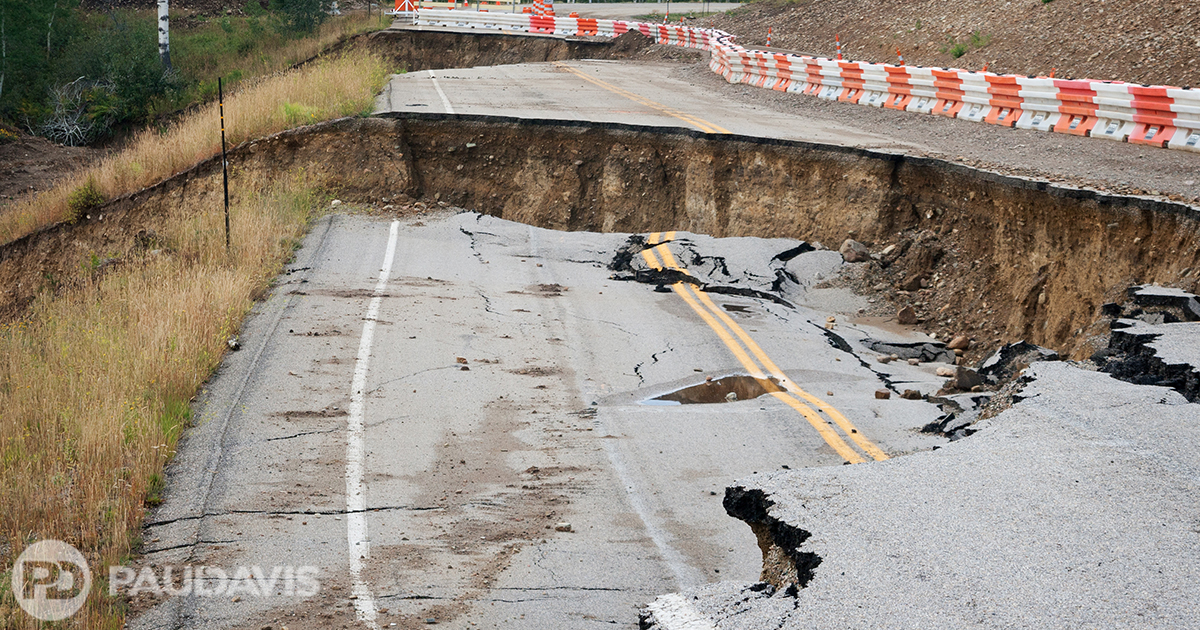
Frightening landslide videos are easy to locate online. In one apocalyptic scene, a forest of majestic trees speeds down the side of a mountain, demolishing a highway in Japan. In another, a hiker captures a dozen landslides triggered by an earthquake in Nepal. A third video tracks a group of eight homes gradually sliding into the sea and sinking.
Viewers come away dumbstruck by nature’s power, relieved that the danger is elsewhere. Or is it? “Landslides occur infrequently in Canada. But they occur across all regions; in the mountain ranges of British Columbia and Alberta, as well as some parts of Quebec and Ontario,” says Joel Moss, President of Paul Davis of Santa Clarita.
Landslides happen because steep slopes become destabilized, causing soil and anything in or on that piece of land – boulders, trees, cars, buildings, power lines, people - to flow downward at speeds that typically range from 16 to 56 kilometers per hour. Terrain, which may gush like liquid, fall away in chunks or rumble along as a cohesive tract, becomes unstable in a variety of ways.
- Lack of vegetation: wildfires or strong storms strip away trees, bushes and grasses whose roots once anchored steep earth in place.
- Storms: rain or snow melt saturated soils, make terrain heavier and more vulnerable to gravity’s pull.
- Seismic activity: earthquakes often trigger landslides as they rearrange the topography. Volcanoes cause landslides and they have a special name: lahars.
- Human activity: road construction or dam building, if not undertaken carefully, can accidentally trigger landslides by removing crucial support and destabilizing terrain.
What’s the best way to prepare? Moss is blunt. “Sheltering in place will not save you from a fast-moving landslide,” Moss cautions. “Evacuate if you are in the path of a possible landslide. Listen to the emergency authorities in your area. Track extreme weather events. And pay attention to your surroundings. Impending landslides may give warning signs.”
Warning signs include:
- Changes in landscape features: Trees that are no longer upright, utility poles that lean, roads that develop new cracks.
- Changes in terrain: Bulging at the foot of slopes, new water seepages, small landslides or rock falls, changes in established stormwater runoff patterns.
- Structural changes: Cracks in pavement or concrete, doors that won’t shut properly, decks that pull away from moorings, utility service components that move, break, stretch or leak.
- Unusual sounds: subtle sounds such as grinding, cracking, popping or falling rocks.
If your property is affected by a landslide or other disaster, rely on The Difference MakersTM at Paul Davis to respond quickly and work to mitigate damage to your home or commercial buildings.
Be Aware of Winter Rains and Latent Mudslide Dangers
Frightening landslide videos are easy to locate online. In one apocalyptic scene, a forest of majestic trees speeds down the side of a mountain, demolishing a highway in Japan. In another, a hiker captures a dozen landslides triggered by an earthquake in Nepal. A third video tracks a group of eight homes gradually sliding into the sea and sinking.
Viewers come away dumbstruck by nature’s power, relieved that the danger is elsewhere. Or is it? “Landslides occur infrequently in Canada. But they occur across all regions; in the mountain ranges of British Columbia and Alberta, as well as some parts of Quebec and Ontario,” says Joel Moss, President of Paul Davis of Santa Clarita.
Landslides happen because steep slopes become destabilized, causing soil and anything in or on that piece of land – boulders, trees, cars, buildings, power lines, people - to flow downward at speeds that typically range from 16 to 56 kilometers per hour. Terrain, which may gush like liquid, fall away in chunks or rumble along as a cohesive tract, becomes unstable in a variety of ways.
- Lack of vegetation: wildfires or strong storms strip away trees, bushes and grasses whose roots once anchored steep earth in place.
- Storms: rain or snow melt saturated soils, make terrain heavier and more vulnerable to gravity’s pull.
- Seismic activity: earthquakes often trigger landslides as they rearrange the topography. Volcanoes cause landslides and they have a special name: lahars.
- Human activity: road construction or dam building, if not undertaken carefully, can accidentally trigger landslides by removing crucial support and destabilizing terrain.
What’s the best way to prepare? Moss is blunt. “Sheltering in place will not save you from a fast-moving landslide,” Moss cautions. “Evacuate if you are in the path of a possible landslide. Listen to the emergency authorities in your area. Track extreme weather events. And pay attention to your surroundings. Impending landslides may give warning signs.”
Warning signs include:
- Changes in landscape features: Trees that are no longer upright, utility poles that lean, roads that develop new cracks.
- Changes in terrain: Bulging at the foot of slopes, new water seepages, small landslides or rock falls, changes in established stormwater runoff patterns.
- Structural changes: Cracks in pavement or concrete, doors that won’t shut properly, decks that pull away from moorings, utility service components that move, break, stretch or leak.
- Unusual sounds: subtle sounds such as grinding, cracking, popping or falling rocks.
If your property is affected by a landslide or other disaster, rely on The Difference MakersTM at Paul Davis to respond quickly and work to mitigate damage to your home or commercial buildings.
